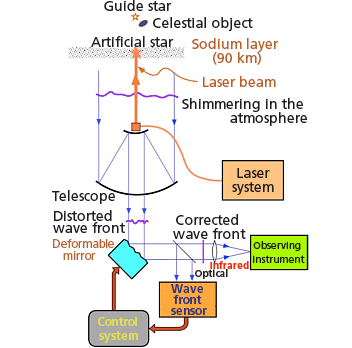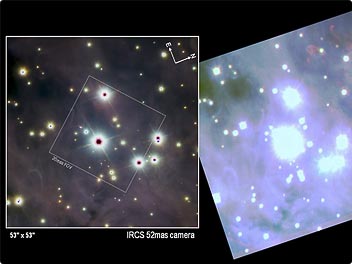Future optical and infrared observation from earth
The Subaru Telescope was completed approximately ten years ago—what does the next ten years hold for it?
The Subaru Telescope came into operation in the year 2000, and there is a lease agreement on the land with the Hawaii State Government that runs until 2033. As the life span of a large-aperture telescope is regarded as between 30 and 50 years, we would like to continue operating it until around 2050, if possible. As for the next ten years, there is an on going program of upgrades in progress, and we are considering replacing the existing Prime Focus Camera with one that has a field of vision that is ten times larger, in order to find many more dark celestial objects. The development of an optical fiber-based spectroscope for multiple celestial objects is also progressing. If all goes according to plan, in ten years time there will be no one who can match us in this field (research into deep space).

Diagram showing the principle of Laser Guide Adaptive Optics. An artificial guide star is generated by illuminating the sodium layer using a laser beam. The light distortion caused by the earth's atmosphere is measured by analyzing the wavefront from the artificial guide star, and is cancelled out in real time.
I would also like to draw attention to “Laser Guide Star Adaptive Optics,” which I am leading and promoting. This is intended to significantly enhance Subaru's imaging capabilities. Testing was completed last year and full operation is due to commence next year or so.
An active optics system is installed on the Subaru Telescope. It uses actuators fitted to the underside of the mirror to correct deformation in the primary mirror under its own weight due to the orientation of the telescope. A basic feature of the Subaru Telescope, adaptive optics (AO) represents miniaturized and accelerated active correction technology that compensates for shimmering in the atmosphere. This system features a thin flexible mirror 10 cm in diameter and 0.1 mm thick attached at the telescope's focal point. Real-time control is performed 2,000 times a second using tiny actuators attached to the underside of the mirror (consisting of 188 bimorph Piezo elements) at an amplitude of approximately one-tenth the wavelength of the light.
Although the light from a celestial object travels tens of billions of light years in a dead straight line, it ends up being distorted when passing through the earth's atmosphere. For this reason, even on the Subaru Telescope (which is supposed to be capable of capturing an extremely small segment of 0.06 seconds of arc, according to the theoretical diffraction limit for an 8-m aperture telescope), the resolution achieved for observation is 0.6 seconds of arc on average.

Orion trapezium of 0.06 seconds of arc obtained in test observations of Laser Guide Adaptive Optics on October 9, 2006 (left). On the right is a trapezium (of 0.6 seconds of arc) photographed in 1999, immediately after the completion of the Subaru Telescope.
With adaptive optics, this disturbance in the atmosphere is cancelled out. Up until now, however, it has only been possible to measure the fluctuation if there is a bright star close to the object being observed. The Laser Guide Star Adaptive Optics that we have constructed involves the combination of adaptive optics with a new device that points a laser beam adjusted to specific wavelengths with a precision of 1 in 10 million at the thick layer of sodium atoms 90-100 km above earth, stimulating the sodium atoms and making them light up (to form the laser guide star). We generate an artificial star in the sky in the direction in which the telescope is pointed, and use the light from it as a basis for correcting the disturbance in the atmosphere. As such, this system can be also used for observation of dark and extremely distant celestial objects that have no bright star in their vicinity.
In the testing phase for this system, the Subaru's diffraction limit of 0.06 seconds of arc was verified. Fascinating new worlds await us in the future, so please share in our anticipation.
Are there plans for the construction of an even larger optical telescope?

Conceptual diagram of the next-generation Extremely Large Telescope (ELT). This consists of a 30-m-aperture reflecting telescope comprised of multiple reflecting mirrors. In the basic research for the ELT, Nikon is cooperating in areas such as raw materials research and surface polishing of reflecting mirrors using new materials.
The Subaru Telescope was initially conceived in 1984 and was completed in 2000. Hence, the idea for the telescope did not come to fruition until 16-17 years after it was first seriously considered. Although the Subaru Telescope's main unit and its observing instruments are functioning extremely well and are yielding abundant scientific results, it is still necessary to consider what will come next. Thus for the past two or three years, we have been seriously considering the possibility of constructing a 30-meter-class Extremely Large Telescope (ELT) to take over the baton. However, it would be impossible for Japan to undertake such large-scale construction and management on its own. For this reason there has recently been much activity to lay the groundwork for international collaboration, and I have been flying around the United States and Europe.
Although we are thinking about a 30-meter telescope to succeed Subaru, it will take at least 10 years to complete. This means that the generation that built the Subaru Telescope will be retiring, and the younger generation that built the observing instruments will be working extensively on the next telescope. We are hoping they will make use of the experience that they acquired building HDS and FOCAS in the construction of the observing instruments for the next-generation telescope. Provided that our Subaru observing instruments upgrade plans go well, the Subaru Telescope will be hugely effective in locating interesting celestial objects in the universe, such as distant galaxies. After that, the celestial objects that it has found will be observed more closely by the 30-m telescope constructed jointly by the USA, Europe, and Japan. This being the case, we think that we can assume leadership of observation and research using the 30-m telescope.

